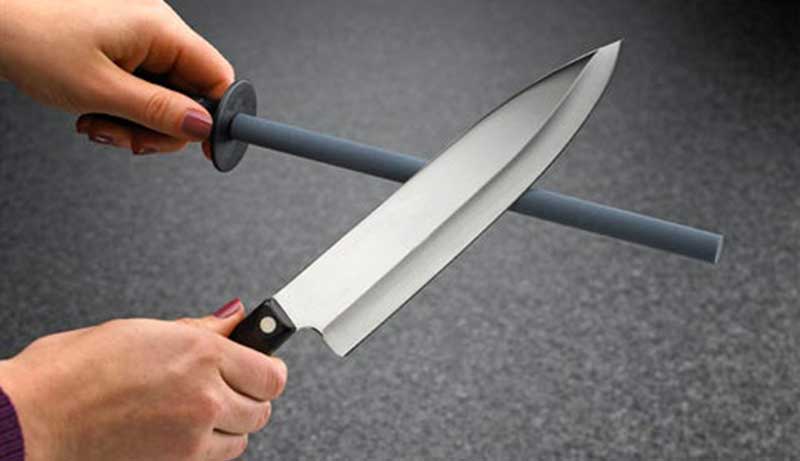Although most users run after the knife brand, we don’t agree with that. For us, it is the quality of the blade that makes or breaks a knife.
And when talking about the quality, how can we overlook the sharpness of the knife blade? A well sharpened blade makes the cooking process way easier.
Nevertheless, the knife blade can become a bit blunt over usage. Hence, we must know how to sharpen a kitchen knife.
In this article, we will have a brief discussion about the sharpening procedure and its importance.
Let’s begin!
Why Should You Sharpen Your Knife?
Table of Contents

When working in the kitchen, nothing can be a bigger enemy than a dull knife. If you think such knives make chopping difficult, that is not the only con.
As a dull knife demands more pressure, it increases the chances of slipping. None of us want to chop our knuckles.
On the contrary, a sharp knife helps to cut evenly within a short span of time. Besides, it creates different kinds of chopping techniques of no sweat.
All in all, a sharp knife affects the food preparation, cooking time, and the outcome drastically. Additionally, you can check our review on Angle for Knife Sharpening.
Mechanism of a Honing Rod
Here comes the interesting part. The mechanism of a honing rod does not allow it to sharpen the knife. Instead, the rod corrects the edges of the blade. That way, the blade comes back to its original state with smooth edges.
With a few strokes, a quality rod will bring back the sharpness of a dull knife. Even while cutting fibrous meat or bony chicken, you can opt for a stroke or two over the rod.
That will bring back the sharpness without much effort. Just wipe off the knife before you go back to cutting and shopping.
Is Your Knife Sharp Enough?
You can find if your knife is sharp enough with a simple paper test. For that, you will need a single paper sheet.
Hold it straight and place the heel of the blade at the top edge of the paper. Now run the knife through the paper from tip to heel in one go, just like you slice vegetables.
If you face any obstacle in this step, your blade probably needs honing. If you still face any resistance, we suggest opting for sharpening the blade.
Steps of How to Sharpen Kitchen Knives With Rod

A quality sharpening still can bring back the dullest knife to life. That brings us to the first step of sharpening kitchen knives- picking a suitable rod.
If you are looking for a sharpening rod, our suggestion will be a Diamond steel rod. While other rods are efficient for honing, their output for sharpening is not satisfactory.
However, these honing rods will clean up the imperfections of the blade with zero toils. Plus, they will leave no room for complaints. You can fix the daily sharpening issues with these rods.
Although honing works for daily issues, we recommend sharpening every 6 months.
When it comes to sharpening kitchen knives with a rod, you can do it in multiple ways. But our job is to help your daily chores a bit easier. So, we tried out multiple methods and landed on a fail-proof one. Even if you are a beginner, you will not face much difficulty.
Step 1:
Holding the steel sharpener correctly is crucial to maintaining overall safety. To position the sharpener accurately, hold the shaft with your non-dominant hand.
Then place the other end on a stable surface. Now press the sharpener on the surface so that the structure gets a strong hold. That way, the sharpener won’t move around while working.
Keep your hand still and you will be good to go. The idea is to maintain the same position throughout the sharpening process.
Step 2:
While positioning the knife is important, you cannot ignore the finger placement. That will assure you get maximum use out of the sharpener.
To operate the device safely, wrap your fingers around the shaft and have a strong hold. Tuck in all the fingers for a better grip.
We see many users rest their index fingers on the top of the blade. However, it increases the risk factor. So, our advice will be to avoid doing that.
But why do we emphasize the hold of the sharpener? Doing so will keep the sharpener immobile when you move the knife up and down.
Step 3:
Now that we have acquired a stable position and strong grip, we can move on to sharpening.
For sharpening, you need to hold the knife in a slightly tilted position. For movement, we will follow a swinging motion. Use your non-dominant hand to hold the rod in place.
Take out the knife and hold it at a 15-degree angle against the rod. The blade should touch the top of the steel rod slightly.
Now slowly move the blade along the length of the steel rod. Consider the motion you will opt for while lighting a match. We want a similar motion in this case. Don’t let the blade touch the countertop.
Alternate and sweep both sides of the blade for a while for desired results.
Step 4:
The last step will be to check if the sharpness is up to par. The paper test will work fine for the inspection here. And you are all done!
Final Words

If you are a novice to this task, we recommend working under the supervision of an expert. That way, you can reduce risk probability by many folds. Here to mention, you can always get the sharpening done from a store.
Nevertheless, doing that on your own will help save some bucks. Why miss the chance, right? We hope our article helped gather enough information about knife honing. Don’t forget to share your honing techniques with us.
Stay safe!
Related Post:

